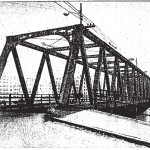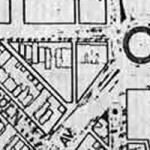
Features
1980s (Lost) & Found II: Dining & Retail
by Patrick Steffes » 12.30.2019 Chicago’s Glass Block Part I – 1893, Early Glass Block, and Prism Glass
by Joe Sislow » 7.17.2016 Look around when you’re out and about Chicago. Check out industrial buildings. Look at basement windows, look at bathroom windows. It’s hard to miss glass block. This ubiquitous architectural detail got me wondering: where did it all come from? Is Chicago unique in its use (possibly abuse) of glass block? And how did we get this way? Read More » Sharply Defined Masses: The Forgotten Work of James F. Eppenstein, Part 3
by Patrick Steffes » 3.20.2015 Unexpected Glamour: The Forgotten Work of James F. Eppenstein, Part 2
by Patrick Steffes » 12.16.2013 Railroads and Chicago Swing Bridges
by Patrick McBriarty » 9.3.2013 While it is easy to overlook the railroads in Chicago nowadays, this city has been a major rail hub if not the most important railroad city in the nation and the world for more than 150 years. Read More » Bertrand Goldberg in Tower Town Part 3: Bertrand Goldberg’s Michigan Avenue Project
by Patrick Steffes » 5.18.2012 Bertrand Goldberg in Tower Town is a three-part set of articles detailing this Chicago-based architect’s one-time residence in the 1930s. This article looks at a beauty salon announced as having been designed by Goldberg. While opened, it may or may not have actually been completed by the architect. This beauty salon opened by 1938 at 840 North Michigan Avenue, on the same same block as Goldberg’s former “commune” residence detailed in part one of this series. Read More » The Bloomingdale Line
by Terence Banich » 5.4.2012 Introduction
On the evening of July 30, 1939, Nancy Froemming “and her ambition” boarded a train in Milwaukee bound for Chicago. Miss Froemming — who thought that she “could sing with the best of them” — had decided that Milwaukee was too small of a town for her nascent singing career and set her sights on the hustle-and-bustle of Chicago. So off she went. There were only two problems with Miss Froemming’s plan: she was 13 years old, and the train she boarded was a freight line — the Bloomingdale Line. Upon alighting at Western Avenue, instead of booking a gig at the Cloister Inn or the Sunset Cafe, Miss Froemming was booked at Juvenile Hall.0.1 Long before it was ever thought of as a trail, the Bloomingdale Line — as it was sometimes known — hauled freight (and, it seems, one young girl’s ambition) for the Chicago, Milwaukee, St. Paul & Pacific Railroad Company, the storied “Milwaukee Road.” The Bloomingdale principally functioned as a connecting line used by freight trains between the north side of Chicago and the railroad’s yards at Galewood and Bensenville.0.2 But perhaps more fundamentally, the branch was a link to the rest of the country; the trains that traversed the Bloomingdale could access the St. Paul’s sprawling, nationwide rail network. Bertrand Goldberg in Tower Town Part 2: Postwar Development of Michigan & Pearson
by Patrick Steffes » 1.30.2012 Bertrand Goldberg in Tower Town Part 1: Bertrand Goldberg’s Commune
by Patrick Steffes » 12.31.2011 Bertrand Goldberg in Tower Town is a three-part set of articles, and the first in a series of several Forgotten Chicago features highlighting the Chicago-based architect’s one-time residence in the 1930s, and lesser-known built and proposed projects in the Chicago area. This article examines Goldberg’s former residence on the site of the former Senator Charles Farwell home Read More » Remnants of the “L”
by Terence Banich » 7.2.2011 Chicago is, as one writer put it, a “city of travelers.”1 The city’s sheer sprawl made that moniker inevitable. It also led to the creation of a transportation system that, at its apogee, consisted of a web of streetcars, diesel buses, electrified trolleybuses and elevated railways and subways. But not every mode of public transportation that once served Chicago is extant today. Read More » Outlying Banks, 1893-1933
by Serhii Chrucky » 4.7.2011 When Thomas J. Harper, president of the West Town State Bank, opened for business on the morning of May 24th, 1930, he could not have known it would be the last such opening for some time. That day, after spending seventeen years in a two story building on West Madison Street Read More » Edgewater Golf Club
by Serhii Chrucky » 12.13.2010 Born out of an elitist North Shore sensibility, the tumultuous transformation of the Edgewater Golf Club into the egalitarian Warren Park reveals much about the complicated process of real estate development in Chicago. Read More » Holiday in Avondale
by Daniel Pogorzelski » 3.22.2010 Chicago historian Dominic Pacyga characterizes Chicago as a snake that transforms itself every generation, shedding its old skin to emerge a new and different creature. Read More » Drama, Documentation & Discontinuity
by Serhii Chrucky » 10.9.2009 Looking at fiction films shot on location in Chicago as documents of a real place, three prevalent themes emerge. Read More » Bridge Out For Good
by Serhii Chrucky » 3.6.2009 In Chicago, a disused or demolished crossing of every type can be found. Here we are focusing on vehicular bridges over water where a connection no longer remains. Read More » Defining the Four Plus One
by Serhii Chrucky » 1.27.2009 The simplest definition of a four plus one is a five story apartment building where the first floor consists of the lobby and a parking lot. Read More » Michael Reese Hospital
by Jacob Kaplan » 1.18.2009 In true Chicago fashion, a plan has been announced and set in stone before anyone has had a chance to comment on it. Read More » Tied Houses
by Serhii Chrucky » 1.11.2009 A “tied house” was a type of saloon that originated in England, but gained infamy in pre-prohibition America. Read More » The Extension and Removal of Ogden Avenue
by Serhii Chrucky » 1.10.2009 Ogden Avenue is an arterial highway in Chicago, running southwest from the near west side. The street was closed to traffic between North Avenue to Armitage Avenue in 1967. Read More » Our Historic Subway Stations
by Serhii Chrucky » 12.16.2008 The stations of Chicago’s Initial System of Subways; the State, and Milwaukee-Dearborn lines, are unique examples of Art Moderne style architecture. Read More » Municipal Parking Garages
by Serhii Chrucky » 12.13.2008 The trend towards municipal parking in North American cities began around 1950, and can be regarded as an effect of postwar prosperity and increasing automobile use. Read More » |

































